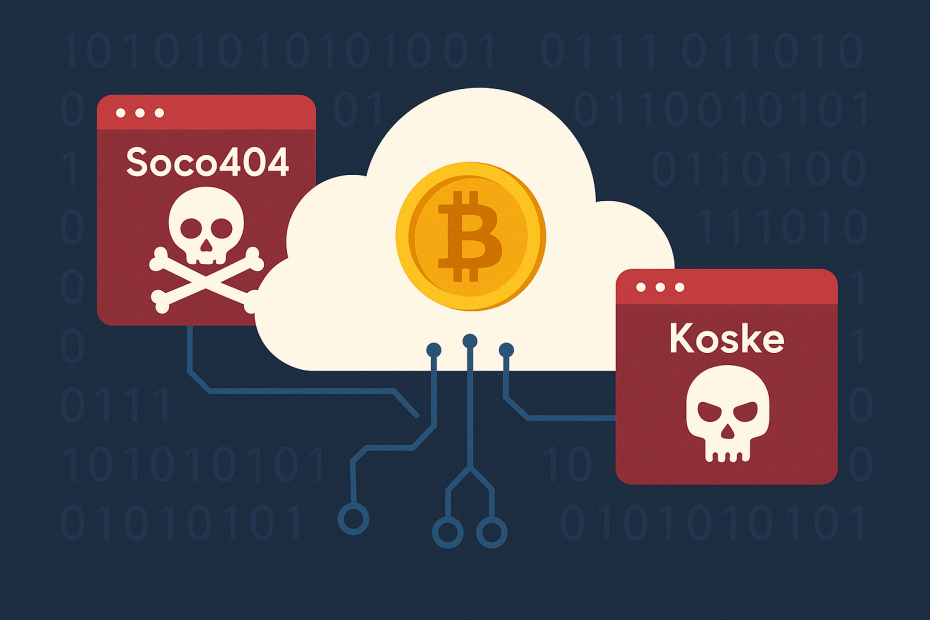Cloud services have become the backbone of modern business operations, especially for small and medium-sized enterprises. However, as cloud adoption grows, so does the risk from increasingly sophisticated cyber threats. Recently, two significant malware campaigns named Soco404 and Koske have emerged, targeting both Linux and Windows cloud systems with the intent to hijack computational resources for cryptocurrency mining.
Unpacking Soco404: A Multi-Platform Cryptomining Campaign
Security researchers have identified the Soco404 campaign leveraging vulnerabilities and misconfigurations in cloud environments to deliver cryptomining payloads. This campaign is unique because it targets both Linux and Windows platforms using platform-specific malware.
- Stealth Techniques: The malware employs process masquerading, making malicious processes look like legitimate system tasks. Its payloads are hidden inside fake 404 HTML error pages hosted on Google Sites, which were used as a deceptive delivery mechanism before being taken down.
- Wide Target Range: Soco404 scans for exposed cloud services such as Apache Tomcat, Apache Struts, Atlassian Confluence, and publicly accessible PostgreSQL databases, exploiting weak credentials and vulnerabilities to gain entry.
- Automated and Opportunistic: The attackers use various native tools including
wget,curl, PowerShell, and certutil, adapting to whichever environment they find for maximum reach. - Efficient Resource Hijacking: Once inside, the malware downloads crypto miners optimized for different hardware, stops competing miners to maximize profits, and attempts to erase traces by overwriting logs.
- Windows-Specific Actions: On Windows, the payload installs a driver to elevate privileges and attempts to disable event logging to evade detection.
This diverse and flexible approach points to a broad automated cryptomining infrastructure that also involves fraudulent cryptocurrency trading platforms, heightening the threat’s complexity.
Meet Koske: An AI-Assisted Linux Threat Leveraging Stealthy File Embedding
The Koske malware represents a new breed of Linux threats believed to have been crafted with the help of large language models (LLMs). Rather than traditional methods, it uses a sophisticated technique involving polyglot files that embed malicious payloads within seemingly innocent JPEG images of pandas.
- Initial Access: Attackers exploit misconfigured servers such as unsecured JupyterLab instances to initiate the infection.
- Malicious Payload Delivery: The malware extracts hidden segments from panda images that contain a C-based rootkit to mask its presence and shell scripts that download cryptocurrency miners.
- Execution In Memory: To avoid antivirus detection, all payloads execute directly in memory without leaving traces on disk.
- Crypto Mining Focus: Koske mines a wide array of cryptocurrencies (at least 18, including Monero and Ravencoin) utilizing both CPU and GPU resources in the infected system.
This technique, while not exactly steganography, abuses the polyglot file format, permitting the malware to evade conventional security scans by hiding malicious shellcode at the end of valid image files.
Implications for Small Businesses Using Cloud Services
These two malware campaigns serve as a critical reminder for small businesses about the necessity of robust cloud security practices. The flexible and cutting-edge tactics employed by Soco404 and Koske highlight how attackers adapt to different platforms and use advanced stealth techniques that can easily slip past standard defenses.
Key Risks Include:
- Resource Drain: Undetected cryptomining can significantly degrade your cloud system performance and inflate costs.
- Security Breaches: Exploited vulnerabilities can lead to broader network compromise beyond just cryptomining.
- Compliance Issues: Lack of control over your cloud resources may put you at risk of violating regulatory requirements.
How to Protect Your Business Against Cross-Platform Cryptomining Attacks
Small business owners relying on cloud services should be proactive in their cybersecurity strategies. Here are practical steps to mitigate these risks:
- Regularly Patch and Update: Ensure all cloud-hosted software, including servers like Apache Tomcat and database engines like PostgreSQL, are updated to patch known vulnerabilities.
- Harden Credentials: Use strong, unique passwords and implement multi-factor authentication to prevent unauthorized access through weak credentials.
- Monitor Cloud Configuration: Regularly audit cloud service configurations to close misconfigurations that attackers exploit.
- Implement Intrusion Detection and Endpoint Protection: Deploy advanced monitoring tools capable of detecting unusual activities such as cryptomining and rootkit behavior across multiple operating systems.
- Restrict Network Access: Limit publicly accessible services and enforce strict firewall rules to reduce the attack surface.
- Engage Professional Cybersecurity Services: Partner with experts who can provide continuous monitoring, rapid response, and tailored protection for your unique cloud environment.
If your business uses cloud infrastructure and you want comprehensive protection tailored to your needs, consider exploring our specialized cloud security solutions. Our Secure Cloud Workspace offering is designed to safeguard cloud environments from threats like Soco404, Koske, and many others, keeping your operations secure and compliant.
Conclusion
The emergence of sophisticated malware campaigns like Soco404 and Koske underscores the evolving nature of cyber threats targeting cloud platforms. Small businesses must remain vigilant, regularly update and configure their cloud services properly, and leverage professional cybersecurity solutions tailored for cloud security. By doing so, you can protect your valuable resources from being exploited for cryptomining and other malicious activities.
Don’t wait for an attack to disrupt your operations. Reach out today to learn how our cybersecurity solutions can shield your cloud assets and keep your business running smoothly.
